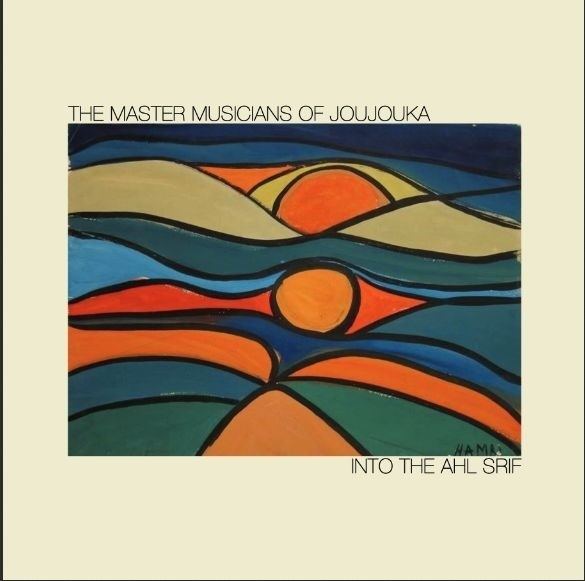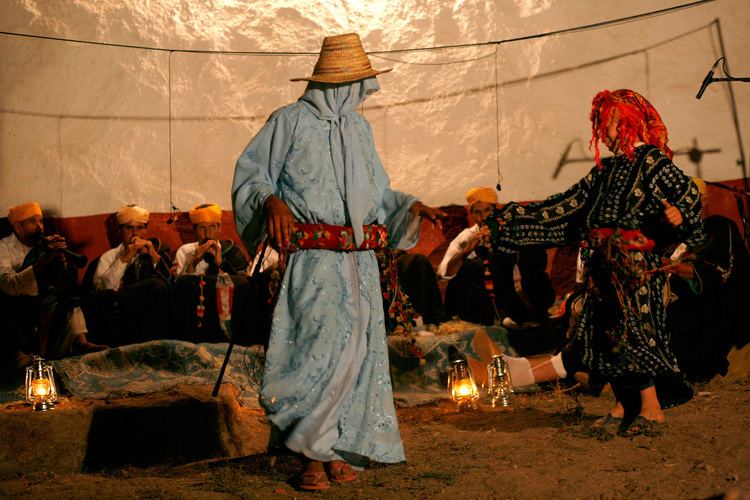Years active 1950–present Record label Rolling Stones Records Genres Folk music, World music | Members See: Members Origin Jajouka, Morocco (1950) | |
 | ||
Labels Sub Rosa, Rolling Stones Records Associated acts Brion Gysin,
Mohamed Hamri,
Brian Jones,
Timothy Leary,
Marianne Faithfull,
Scanner,
Anita Pallenberg,
Smashing Pumpkins Website Master Musicians of Joujouka official site Albums Brian Jones Presents t, Boujeloud, Joujouka Black Eyes, Apocalypse Across the Sky, Master Musicians of Jajouk | ||
The master musicians of joujouka take me with you darling take me with you
The Master Musicians of Joujouka are Jbala Sufi trance musicians most famous for their connections with the Beat Generation and the Rolling Stones founder Brian Jones. These musicians hail from the village of Jajouka or Zahjouka near Ksar-el-Kebir in the Ahl Srif mountain range of the southern Rif Mountains in northern Morocco.
Contents
- The master musicians of joujouka take me with you darling take me with you
- Background
- Schism
- Sufism and Pan
- Beat Generation
- Brian Jones and Ornette Coleman
- 1990s to present CD and DVD releases
- Music and instruments
- Brian Jones 40th Anniversary Festival
- Discography
- Books
- Personnel
- Songs
- References

Background

The Master Musicians of Joujouka have a long history being recorded by Western artists. Arnold Stahl produced an LP record, Tribe Ahl Serif: Master Musicians Of Jajouka, recorded on location as part of a documentary film written and produced by Stahl. This double album was released in the early 1970s by the Musical Heritage Society. During the 1970s, the French label Disque Arion released a single album of the same music, produced by Stahl and titled Le Rif: La tribu Ahl Serif. Both albums are credited to Master Musicians of Jajouka (or Maîtres musiciens de Jajouka). The name Master Musicians of Joujouka was first used by Brion Gysin and William S. Burroughs in the 1950s, Timothy Leary and Rosemary Woodruff Leary in the 1960s and 1970s, and on the Brian Jones L.P. released in 1971. In the 1980s the musicians were sometimes called by the names Master Musicians of Jahjouka, Master Musicians of Jajouka and Master Musicians of Joujouka in both articles and on official documents.
Schism

A schism exists between two similarly-named ensembles from the same village. Lee Ranaldo, following a 1995 visit to Morocco, wrote

[T]here are currently two groups of musicians claiming to be the 'real' Master Musicians OF Jajouka/Joujouka (they're even arguing over the spelling). One group, the 'Jajouka' faction, is led by Bachir Attar, whose father was the leader of the group in the 60s when Brian Jones and Ornette Coleman made their visits.... The 'Joujouka' faction is in the care of Mohammed Hamri, who has been involved with the village since the 50s and 60s, and who had a hand in bringing Brion Gysin and Paul Bowles there.
Inconsistent English rendering of the village's name compounds the issue. For example, RE/Search uses both spellings in an interview with Brion Gysin: "Jajouka" for the village name, and "Joujouka" for the album Brian Jones Presents the Pipes of Pan at Joujouka.
Sufism and Pan
The Master Musicians of Joujouka adhere to the traditional Sufi trance music of their patron saint passed down for 1200 years. Timothy Leary having visited the village in September 1969 wrote an essay on his time with Mohamed Hamri and the master musicians in his 1971 book Jail Notes called "The four thousand year old rock'n'roll band". Leary based his dating on Burroughs's belief that the ritual Boujeloud, performed in Joujouka, owes its origin to the Ancient Greek deity Pan.
Before the Alaouite dynasty, the masters used to play in medieval times for sultans in their courts, travelling with them and announcing their arrival to villages and cities.
Beat Generation
Their first exposure to Western audiences came through their introduction to the Beats. Painter/folklorist Mohamed Hamri, whose mother was an Attar from the village, led artist Brion Gysin to Joujouka to meet the group. Gysin became fascinated with the group's music and led William S. Burroughs to the village. Burroughs described it as the world's oldest music and was the first person to call the musicians a "4000-year-old rock and roll band". In Tangier, Gysin and Hamri founded the 1001 Nights restaurant, in which the musicians played throughout the 1950s to a largely Western audience in what was then an international zone, the "Interzone" of Burroughs' fiction.
Brian Jones and Ornette Coleman
When Rolling Stones Brian Jones visited Morocco in 1968, Gysin and Hamri took him to the village to record the Master Musicians of Joujouka for the release Brian Jones Presents the Pipes of Pan at Joujouka, whose original release featured cover artwork by Hamri before a controversial 1990s redesign. Ornette Coleman recorded with the musicians in January 1973, some results of which featured on his LP Dancing in Your Head.
1990s to present CD and DVD releases
The Master Musicians of Joujouka, now led by Ahmed Attar, released their third album Joujouka Black Eyes, on Sub Rosa in 1995. In 1996 Sufi: Moroccan Trance II was released, an album featuring the Sufi music of Joujouka's saint Sidi Ahmed Scheech and also Gnawa music from Marrakesh. The same year 10%: file under Burroughs featured the Master Musicians in collaboration with Marianne Faithfull on "My Only Friend," an homage to Brion Gysin, as well as a prayer giving blessings and a vocal track by the musicians. The same CD features artists such as Scanner sampling the musicians to create homages to Gysin and Burroughs. Other artists on album include Bill Laswell, Herbert Huncke, Burroughs, Bomb the Bass, Gysin, Chuck Prophet, and Stanley Booth.
Hamri continued to promote Joujouka music as President of their collectives organisation Association Srifiya Folkloric until his death in Joujouka in August 2000. Despite Hamri's death, the musicians continue to work in Joujouka and abroad. Those living in the village include Ahmed El Attar, Abdeslam Boukhzar, Mohamed El Attar, Abdeslam Errtoubi, Ahmed Bousini, Mustapha El Attar, Radi El Khalil, Abdullah Ziyat, and Mohamed Mokhchan, as well as other members of their Sufi community and their children.
The musicians travelled to perform at Casa Da Musica, Porto, Portugal in spring 2006. Their most recent CD Boujeloud recorded over a four-year period, documents the music of the Boujeloud or Pan ritual, was released in September 2006.
A DVD, Destroy all Rational Thought, featuring their 1992 performances at the Here To Go Show in Dublin, Ireland was released in 2007. The documentary also feature the music of Laswell, Material, and Shabba Ranks. It also features Gysin and Burroughs, whose works were the focus of the show.
Music and instruments
The Joujouka brotherhood play a form of reed, pipe, and percussion music that relies on drones, improvisation, and complex rhythms, much of which is unique to Joujouka.
Their flute is called the lira and is considered the oldest instrument in Joujouka. The double-reed instrument is called the rhaita; it is similar to an oboe, but possessing a louder sound and more penetrating tone. The drum is called the tebel and is made of goat skin and played with two wooden sticks. There is also another goat-skin drum called the tarija which allows for more fast-paced virtuosity.
The music itself is considered to be part of the Sufi tradition of the Rif Mountains. Prior to the colonization of Morocco by France and Spain, master musicians of the village were said to be the royal musicians of the sultans. In past centuries master musicians of the Joujouka village traditionally were excused by the country's rulers from manual labor, goat-herding, and farming to concentrate on their music because the music's powerful trance rhythms and droning woodwinds were traditionally considered to have the power to heal the sick.
The music of the region has a strong connection to Pan. According to the tale, thousands of years ago a goat-man called "Bou Jeloud" appeared to an Attar ancestor in a cave, and danced to his music. The musicians of the village re-enact this event annually.
Brian Jones 40th Anniversary Festival
The Master Musicians of Joujouka host a festival, on 29 July 2008, to celebrate the 40th anniversary of the Brian Jones recording on 29 July 1968.
Discography
Books
Personnel
The following musicians performed on Boujeloud, Joujouka Black Eyes, and Sufi as well as other recordings.
Songs
my brother and my loveJoujouka Black Eyes · 1995
Saudia - girl of the mountainJoujouka Black Eyes · 1995
Mohamed my ProphetJoujouka Black Eyes · 1995
